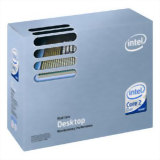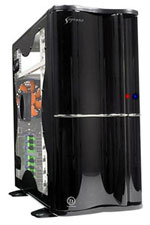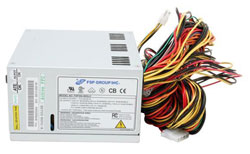Upgraded Intel Midrange Platform
If we had to choose one system as an overall recommendation today, it would have to be this upgraded Core 2 Duo configuration. There are almost no compromises made, and without spending significantly more money it will be difficult to improve performance. As usual, the one exception is gaming, where a faster, more expensive GPU is almost always a possibility. Below is our upgraded Intel recommendation.
 |
As with the AMD platform, our upgraded Intel system has moved up one rung on the performance ladder. Moving from the E6300 to the E6400 represents a 14% CPU speed increase, and it comes with a 23% price increase. Bang for the buck is actually better than the AMD upgrade, but there are other advantages as well. The base clock speed is now 2.13 GHz with an 8X multiplier. Clock speeds of beyond 3 GHz should now be achievable, with a 400 MHz front side bus equating to a 3.2 GHz CPU. Even without overclocking, the E6400 is no slouch, generally offering performance that falls somewhere between that of the Athlon X2 4600+ and 5000+. With overclocking, the E6400 at 3.0 GHz appears to be out of reach of anything AMD can offer with their current architecture and process technology, all at a price of about $225.
You could upgrade to 4MB of cache and 2.4 GHz for another $90 if you so desire, and there are various reasons to do so. The increased clock speed will improve performance about 12%, and the larger L2 cache will on average add another 5% to performance - assuming nothing else is your bottleneck - for a total speed increase of about 18%. The price increase is 41% however, so you are essentially getting 1-for-2 performance scaling. If you are more concerned with CPU performance, the E6600 is a nice upgrade; for gamers you would be much better off spending the money on a faster GPU.
 |
For the upgraded configuration, we still couldn't go with a super high-end motherboard, but we did upgrade to a motherboard that should offer some great overclocking potential. The Gigabyte GA-965P-S3 first showed up in our labs as a pretty mediocre offering, but with the latest BIOS updates it has turned into a real gem. The Gigabyte DS3 will still overclock a bit better in terms of maximum bus speed, but you're much more likely to run into the limitations of your memory and/or processor first. 400 MHz bus speeds are easily achievable on the S3, and a 3.2 GHz Core 2 Duo processor is extremely fast. Note that you do only get a single X16 graphics slot, so if you want more gaming performance you will have to resort to something like the 7950 GX2 cards or wait for faster models to arrive on the market.
Again, we've already looked at the memory and video card options with the upgraded AMD configuration, so let's move on to the storage and other components. We stuck with the NEC ND-3550A DVD-RW drive for all of the reasons we listed previously and we also kept the same mouse, keyboard, and operating system to keep things simple. On the hard drive, we make the upgrade to a slightly larger 320GB model that supports 16MB of cache and comes with a five year warranty from Seagate. Western Digital, Samsung, Maxtor, and Hitachi are again competitive with slightly varying features and performance.
 |
Where we made a big change over the baseline configuration is the choice of case and power supply. Opinions on cases are going to vary widely from person to person. What one person thinks looks awesome another person is going to think looks garish; slick and sleek for us might be dull and boring for you. The Thermaltake Soprano is a nice looking case, at least in our opinion, and you get two 120mm fans that provide a good amount of air flow without creating a ton of noise. The case also features a mostly tool-less design, and you can get it with or without a side window. If you don't like the case that we picked, by all means go out and select a case that you do like. Sticking with the baseline case is certainly an option to save money, although the power supply is a different matter.
 |
While we still haven't created a configuration that really needs an extremely high-end power supply, if you are going to spend money for a quality aftermarket power supply there's no reason to save $10-$15 and miss out on some features that might prove useful in the long run. Fotron Source is one of the most well-regarded power supply manufacturers, and several well-known power supply providers basically offer rebranded Fotron Source PSUs. We did have to draw the line somewhere, so you won't see is recommending $150+ power supplies for a midrange computer. We ended up settling on the 550W SLI ready FSP550-80GLC, which offers plenty of power, relatively silent operation, and it's ready for multiple graphics cards should you ever decide to take that step.
If you only intend to run a single GPU and you aren't going to overclock, many of our upgrade options could easily be changed. The RAM in particular was chosen to really allow some overclocking headroom, but you could stick with the cheaper RAM and instead simply buy a faster CPU. Getting a good quality PSU is rarely a bad decision, but for non-overclockers you can stick with a bundled PSU of around 400W and you shouldn't have problems. In the end, we are limited in the number of configurations we can list due to time constraints, but by all means feel free to ask or comment on the component choices, as there is no "one size fits all" computer system.














49 Comments
View All Comments
fungry - Tuesday, September 26, 2006 - link
i can pretty much agree the appear to be skimpy PSU... never heard of them either. Apart from that, couldn't you say a 1000USD PC pricy enough? I'm not sure, but i consider this to be a mid range o_O.Araemo - Tuesday, September 26, 2006 - link
FSP group is a well-regarded PSU brand. I did quite a bit of research on it this year, and the anecdotal evidence(Large #s of users) recommending them for longevity and quality is suprisingly overwhelming, for a company I had almost never heard of.They definately aren't bargain-basement either, but they do skimp on features in their cheaper PSUs(Why would ANYONE build a PSU with only one SATA connector? Only two I can understand, barely, but one? geeze...)
KraftyOne - Tuesday, September 26, 2006 - link
About the recommendation to buy Media Center Edition...it is built on XP Professional and is pretty easy to modify to basically become professional so that you can join a domain. Here is insturctions from some guy on how to do so:http://extended64.com/blogs/rafael/articles/404.as...">http://extended64.com/blogs/rafael/articles/404.as...
There is no reason to spend the extra money on XP Professional.
KraftyOne - Tuesday, September 26, 2006 - link
typo:insturctions = instructions
mostlyprudent - Tuesday, September 26, 2006 - link
Other cases I would choose include:COOLER MASTER Centurion 5 CAC-T05-UWC Black/Silver Aluminum Bezel, SECC Chassis ATX Mid Tower Computer Case 380W Power Supply - Retail $75
or
ntec NSK 4400 Black/Silver 0.8mm cold-rolled steel construction ATX Mini Tower Computer Case 380W Power Supply - Retail $75
Both offer a little more in the power supply area.
vailr - Tuesday, September 26, 2006 - link
LIAN LI PC-7B plus II Black Aluminum ATX Mid Tower Computer Case - $79.99http://www.newegg.com/Product/Product.asp?Item=N82...">http://www.newegg.com/Product/Product.asp?Item=N82...
OCZ Gold 2GB (2 x 1GB) 240-Pin DDR2 SDRAM DDR2 800 (PC2 6400) - ($209.99 after $20.00 Mail-In Rebate)
http://www.newegg.com/Product/Product.asp?Item=N82...">http://www.newegg.com/Product/Product.asp?Item=N82...
Zalman USA ZM-460-APS 460W VER2.03 Sli Capable (not stocked at Newegg)
http://www.shentech.com/zm460apsdh.html">http://www.shentech.com/zm460apsdh.html
mostlyprudent - Tuesday, September 26, 2006 - link
BTW, the Intel table omits the keyboard/mouse combo.JarredWalton - Tuesday, September 26, 2006 - link
Fixed, thanks! Been a long night....mostlyprudent - Tuesday, September 26, 2006 - link
I have been waiting for this one. Thanks